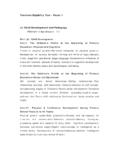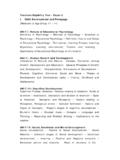Transcription of PART I / CHILD DEVELOPMENT AND PEDAGOGY
1 PART I / CHILD DEVELOPMENT AND PEDAGOGY / Directions : Answer the following questions by selecting the most appropriate option. 1. A creative learner refers to one who is (1) very talented in drawing and painting (2) highly intelligent (3) capable of scoring consistently good marks in tests (4) good at lateral thinking and problem solving 2. Individual learners differ from each other in (1) principles of growth and DEVELOPMENT (2) rate of DEVELOPMENT (3) sequence of DEVELOPMENT (4) general capacity for DEVELOPMENT 3. Every learner is unique means that (1) No two learners are alike in their abilities, interests and talents (2) Learners do not have any common qualities, nor do they share common goals (3) A common curriculum for all learners is not possible (4) It is impossible to develop the potential of learners in a heterogeneous class 4.
2 Constructivism as a theory (1) focuses on the role of imitation (2) emphasises the role of the learner in constructing his own view of the world (3) emphasises on memorising information and testing through recall (4) emphasises on the dominant role of the teacher 5. DEVELOPMENT of concepts is primarily a part of (1) emotional DEVELOPMENT (2) intellectual DEVELOPMENT (3) physical DEVELOPMENT (4) social DEVELOPMENT 6. Heredity is considered as a _____ social structure. (1) primary (2) secondary (3) dynamic (4) static 7. The most intense and crucial socialization takes place (1) throughout the life of a person (2) during adolescence P (3) during early childhood (4) during adulthood 8.
3 Helping learners recapitulate or recall what they have already learnt is important because (1) it is a convenient beginning for any classroom instruction (2) relating new information to prior knowledge enhances learning (3) it is an effective way of revising old lessons (4) it enhances the memory of learners thereby strengthening learning 9. According to Piaget, during the first stage of DEVELOPMENT (birth to about 2 years age), a CHILD learns best (1) by using the senses (2) by comprehending neutral words (3) by thinking in an abstract fashion (4) by applying newly acquired knowledge of language 10. Theory of learning which totally and only depends on observable behaviour is associated with _____ theory of learning.
4 (1) Cognitivist (2) Developmental (3) Behaviourist (4) Constructivist 11. Multilingual character of Indian society should be seen as (1) a hindrance in teaching-learning process (2) a resource for enrichment of school life (3) a challenge to teacher s capacity to motivate students to learn (4) a factor that makes school life a complex experience for the learners 12. Creative answers require (1) direct teaching and direct questions (2) content-based questions (3) open-ended questions (4) a highly disciplined classroom 13. Diagnosis of the gaps in the learning of students should be followed by (1) appropriate remedial measures (2) intensive drill and practice (3) systematic revision of all lessons (4) reporting the findings to learners and parents 14.
5 Which of the following statements cannot be considered as a feature of learning ? (1) Learning is a process that mediates behaviour P (2) Learning is something that occurs as a result of certain experiences (3) Study of behaviour is learning (4) Unlearning is also a part of learning 15. Self-regulation of learners refers to (1) their ability to monitor their own learning (2) creating regulations for student behaviour (3) rules and regulations made by the student body (4) self-discipline and control 16. Which of the following does not reflect teaching for understanding ?
6 (1) Ask students to explain a phenomenon or a concept in their own words (2) Teach students to provide examples to illustrate how a law works (3) Help students see similarities and differences and generate analogies (4) Enable students to memorize isolated facts and procedures 17. Which of the following statements is true about learning ? (1) Errors made by children indicate that no learning has taken place. (2) Learning is effective in an environment that is emotionally positive and satisfying for the learners. (3) Learning is not affected by emotional factors at any stage of learning. (4) Learning is fundamentally a mental activity. 18. Human DEVELOPMENT is based on certain principles.
7 Which of the following is not a principle of human DEVELOPMENT ? (1) Continuity (2) Sequentiality (3) General to Specific (4) Reversible 19. The main purpose of assessment should be (1) to point out the errors of the learners (2) to measure the achievement of learners (3) to decide if a student should be promoted to the next class (4) to diagnose and remedy gaps in learning 20. Centrally sponsored scheme of Integrated Education for disabled children aims at providing educational opportunities to children with disabilities in (1) regular schools (2) special schools (3) open schools (4) Blind Relief Association schools 21.
8 Which of the following is not a sign of reading difficulty among young learners ? Difficulty in (1) letter and word recognition P (2) reading speed and fluency (3) understanding words and ideas (4) spelling consistency 22. A teacher wants the gifted children of her class to achieve their potential.
9 Which of the following should she not do to achieve her objective ? (1) Teach them to enjoy non-academic activities (2) Teach them to manage stress (3) Segregate them from their peers for special attention (4) Challenge them to enhance their creativity 23. Which of the following is not a characteristic feature of intrinsically motivated children ? (1) They always succeed (2) They enjoy doing their work (3) They display a high level of energy while working (4) They like challenging tasks 24. Which of the following is not an appropriate tool for Formative Assessment ? (1) Assignment (2) Oral questions (3) Term test (4) Quiz and games 25. Learners should not be encouraged to (1) ask as many questions as possible both inside and outside the class (2) actively interact with other learners in group work (3) participate in as many co-curricular activities as possible (4) memorize all the answers to questions which the teacher may ask 26.
10 Irfan breaks toys and dismantles them to explore their components. What would you do ? (1) Never let Irfan play with toys (2) Always keep a close watch (3) Encourage his inquisitive nature and channelise his energy (4) Make him understand that toys should not be broken 27. The statement Men are generally more intelligent than women (1) is true (2) may be true (3) shows gender bias (4) is true for different domains of intelligence 28. Understanding the principles of DEVELOPMENT of a CHILD helps a teacher in (1) identifying the social status of the learner (2) identifying the economic background of the learner (3) rationalizing why the learner ought to be taught (4) effectively catering to the different learning styles of learners 29.









